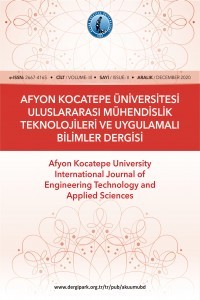Akrilik Örme Kumaşlarda Renk Değişimi ve Desen Değişiminin Performans ve Isıl Özelliklerine Etkisinin İncelenmesi
Bu araştırmada kullanılacak numuneler, iplikler 35/2 NM %100 akrilik olacak şekilde üretilmiştir. İplikler [%40 Akrilik (2.75 dtex unrelax), %60 Akrilik (2,2 dtex relax pilling)] karışım oranlarından oluşmakta ve bu liflere tow boyama işlemi uygulanmıştır. Bu elyaf boyama işleminde 2 grup oluşturularak 2 açık renkli elyaf, 2 orta renkli elyaf, 2 koyu renkli elyaf ve 2 süper koyu boyalı elyaf üretilmiş ve toplam 8 boyalı iplik elde edilmiştir. Elde edilen ipliklerden ribana ve düz örgü kumaşlar üretilmiştir. Elde edilen on altı numune üzerinde kalınlık, hava geçirgenliği, alambeta, patlama testi ve iplik mukavemeti testleri yapılarak sıcaklık ve boyama sürelerinin boyama reçetelerine etkisi araştırılmıştır.
Anahtar Kelimeler:
Akrilik, ısıl soğurganlık, patlama mukavemeti, hava geçirgenliği, iplik mukavemeti
Investigation of The Effect of Colour Variation and Pattern Change on Performance and Thermal Properties of Acrylic Knitted Fabrics
Samples that are going to be used in this research are produced in such a way that the threads are 35/2 NM 100% acrylic. The yarns consist of [40% Acrylic (2.75 dtex unrelax), 60% Acrylic (2.2 dtex relax pilling)] mixing ratios and tow dyeing process has been applied to these fibers. In this fibre dyeing process, by creating 2 groups, 2 light colored fibers, 2 medium-colored fibers, 2 dark colored fibers and 2 super dark dyed fibers were produced and a total of 8 dyed yarns were obtained. Rib and plain knit fabrics were produced from the yarns obtained. The effects of temperature and dyeing times on dyeing recipes were investigated by performing thickness, air permeability, alambeta, bursting test and yarn strength tests on sixteen samples obtained.
Keywords:
Acrylic, thermal absorptivity, bursting strength, air permeability, yarn strength,
___
- Sadeghi-Kiakhani, M., & Tehrani-Bagha, A. R. (2016). Retarding action of poly(amidoamine) dendrimers and cationic gemini surfactants in acrylic dyeing. Dyes and Pigments, 125, 323–330. https://doi.org/10.1016/j.dyepig.2015.10.037.
- Jiang, H., Guo, G., Chen, W., & Cui, Z. (2021). Reactive dyeing of synthetic fibers employing dyes containing a diazirine moiety. Dyes and Pigments, 194, 109555. https://doi.org/10.1016/j.dyepig.2021.109555.
- R. David, H. Geoffrey. (1990). The Chemistry and Application of Dyes, New York and London. M.M. Kamel, H.M. Helmy, H.M. Mashaly, H.H. Kafafy. (2010). Ultrasonic assisted dye-ing: dyeing of acrylic fabrics C.I. Astrazon Basic Red 5BL 200%, UltrasonicsSonochem. 17 92–97.
- Sadeghi-Kiakhani, M., & Tehrani-Bagha, A. R. (2015). Cationic ester-containing Gemini surfactants as retarders in acrylic dyeing. Colloids and Surfaces A: Physicochemical and Engineering Aspects, 479, 52–59. https://doi.org/10.1016/j.colsurfa.2015.03.030
- Uyanık S. & Kaynak H. 2018. PAMUKLU/ELASTAN SÜPREM KUMAŞLARDA FİZİKSEL, BOYUTSAL VE GÖRÜNÜM ÖZELLİKLERİ. Journal of Textiles and Engineer. Cilt (Vol): 25 Sayı (No): 110. https://doi.org/10.7216/1300759920182511007.
- Saçak M., 2007. Lif ve Elyaf Kimyası.Cilt(Vol): 2. 978-975-8640-26-3.
- Türksoy H., S. Üstüntağ and G. Çarkıt. 2017. Thermal Comfort Properties of Fabrics Knitted from Bamboo/Cotton Blended Yarns. Dokuz Eylul University-Faculty of Engineering Journal of Science and Engineering, Volume 19, Issue 56, May 2017. DOI: 10.21205/deufmd.2017195649.
- Değirmenci, Z. and N. Celik. 2016. Investigation of Thermal Comfort Properties of Jeggings Manufactured by the Use of Knitted Denim-Like Fabrics. Journal of Testing and Evaluation, Vol. 44, No. 1, pp. 268– 279, doi:10.1520/JTE20140165. ISSN 0090-3973.
- Yavaşcaoğlu A., Eren R. and Süle G. 2018. EFFECTS OF USAGE ACRYLIC YARN ON THERMAL COMFORT AND MOISTURE MANAGEMENT PROPERTIES OF WOVEN SHIRTING FABRICS. TEKSTİL ve KONFEKSİYON 28(2).
- TİYEK, İ., & Bozdoğan, F. (2005). Akrilik lif üretiminde koagülasyon banyosunun önemi. Pamukkale Üniversitesi Mühendislik Bilimleri Dergisi, 11(3), 319-323.
- Tunç, S. (2012). Meta aramid kumaşın boyanması, haslık yönünden elyaf boyalı meta aramid kumaşlarla karşılaştırılması (Master's thesis, Namık Kemal Üniversitesi).
- Yayın Aralığı: Yılda 2 Sayı
- Başlangıç: 2018
- Yayıncı: Afyon Kocatepe Üniversitesi
Sayıdaki Diğer Makaleler
Derin öğrenme tabanlı Elektrikli Ev Aletleri Veri Setinin Sınıflandırılması
Pankreas Kanserinin Erken Evrelerde Teşhisi için Yapılan Biyosensör Çalışmaları
Mermer Türlerinin Makine Öğrenmesi Teknikleri Kullanılarak Sınıflandırılması
Leonarditin Hidrosiklon ile ön Zenginleştirilmesinin Alkali Liç Verimi Üzerine Etkisi
Spoyler Tasarımı ve Kullanılan ABS ve Karbon Fiber Malzemelerin Analizi
Mehmet ÇAKMAKKAYA, Furkan SOYLU
